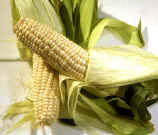|






|
|
Corn is the only native American cereal grain and originated in Mexico or
Central America, and migrated south to Peru archeological evidence as far
back as 7,000 years ago and played an important role in Mayan, Aztec, and Incan cultures-used for religious
ceremonies, as currency, fuel, construction material, jewelry, food
currency, fuel, construction material, jewelry, food
Columbus brought back reports of corn to Spain after his first voyage in
1492, but Hernan Cortes is credited with actually bringing corn back to
Europe; the Portuguese brought it to Africa in early 16th century.
Maize/Corn became popular approximately fifty years after Christopher
Columbus' first voyage in 1492, and with it the curse of the new world:
Pellagra. Pellagra. is a disease that is caused by a niacin or vitamin
B deficiency. Also occurring by the body's inability to break down or
absorb the niacin in the corn. When the maize was used in the new
world by the Christian colonists or throughout Europe, planting
instructions did not come with it, nor culinary usage. When Maise
became the main item in the diet for the poor in the way of a porridge;
other vegetables were not eaten with the mixture because of distaste. However, the Indians had learned to process the corn in an alkaloid to
remove the tough outer hull or seed coat and releases some of the niacin
as well as eating beans and turkey. Pellagra was a main killer in the
early years of this country and by the eighteenth century had spread from
Spain to the rest of Europe.Every part of the
plant can be used, the husks for tamales, the silk for medicinal tea, the
kernels for food, and the stalks for livestock feed.
Popcorn was first noted being served at the feast the
pilgrims were given to keep them alive by the Native Americans, or the
first Thanksgiving Dinner.
Maise/ Corn is a very sacred food and plant to the native Americans.
Colored corn is used in ceremonies. especially the four colors of the
cardinal points: yellow for the north. blue for the west. red for the
south. and white for the east.
                                
         |